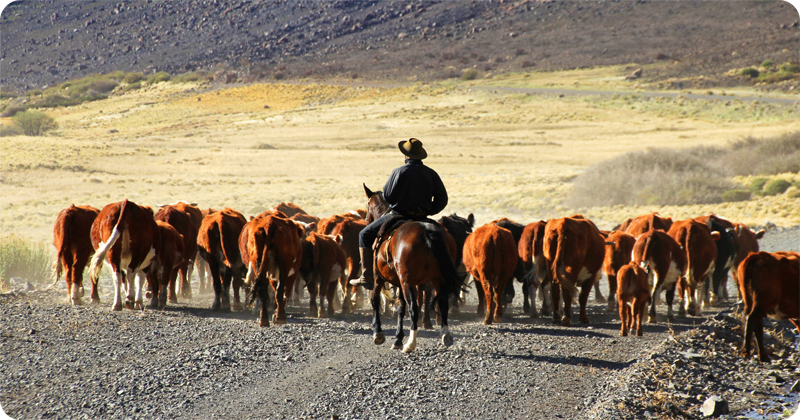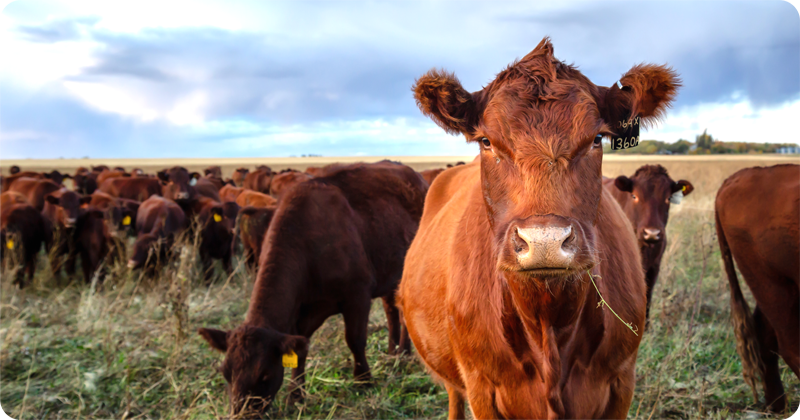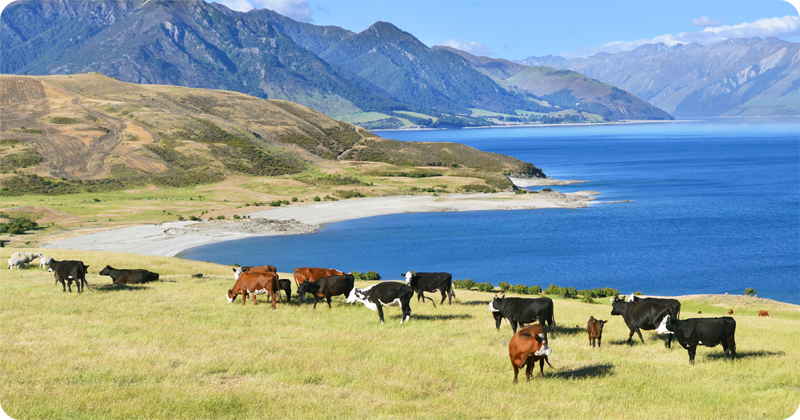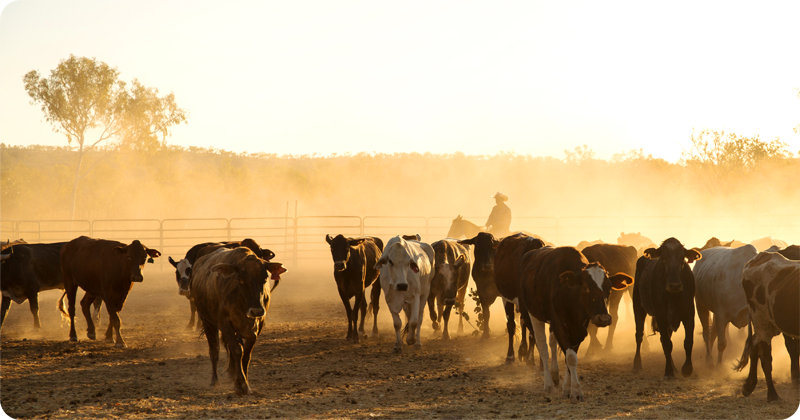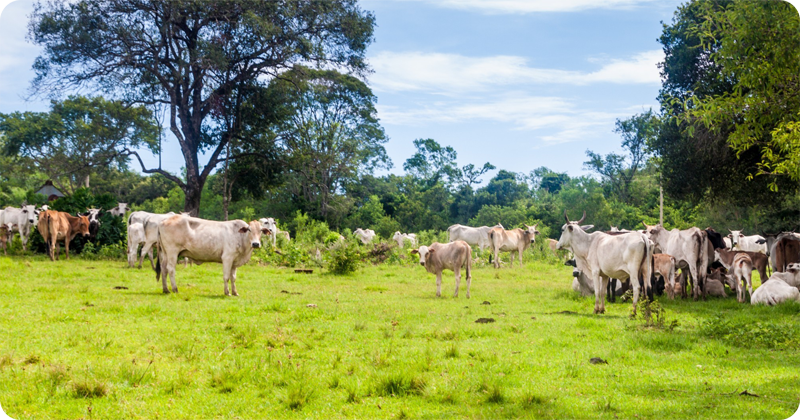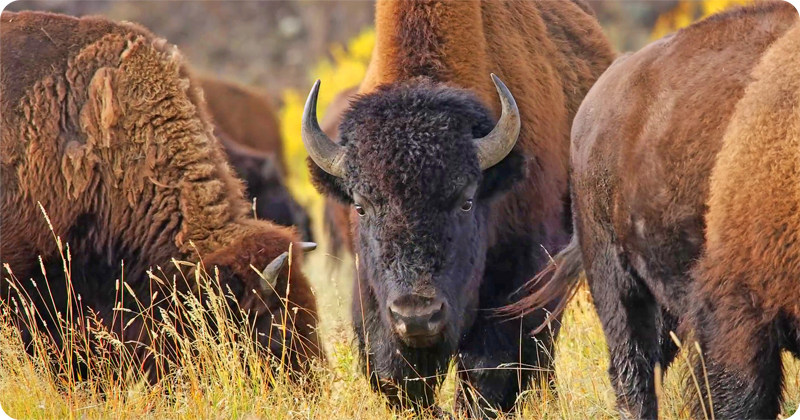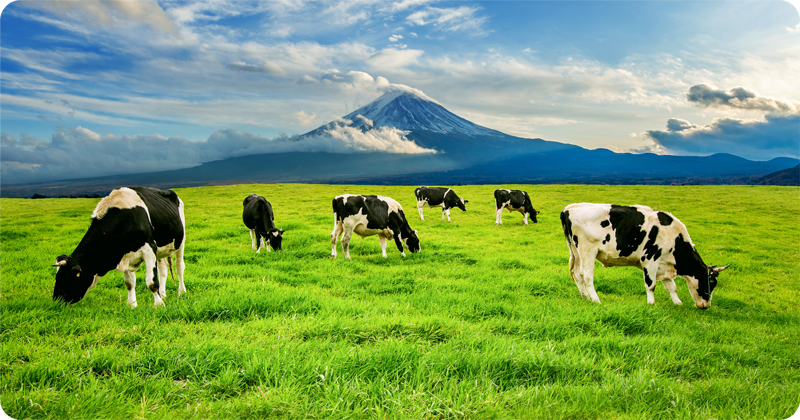
URUGUAY
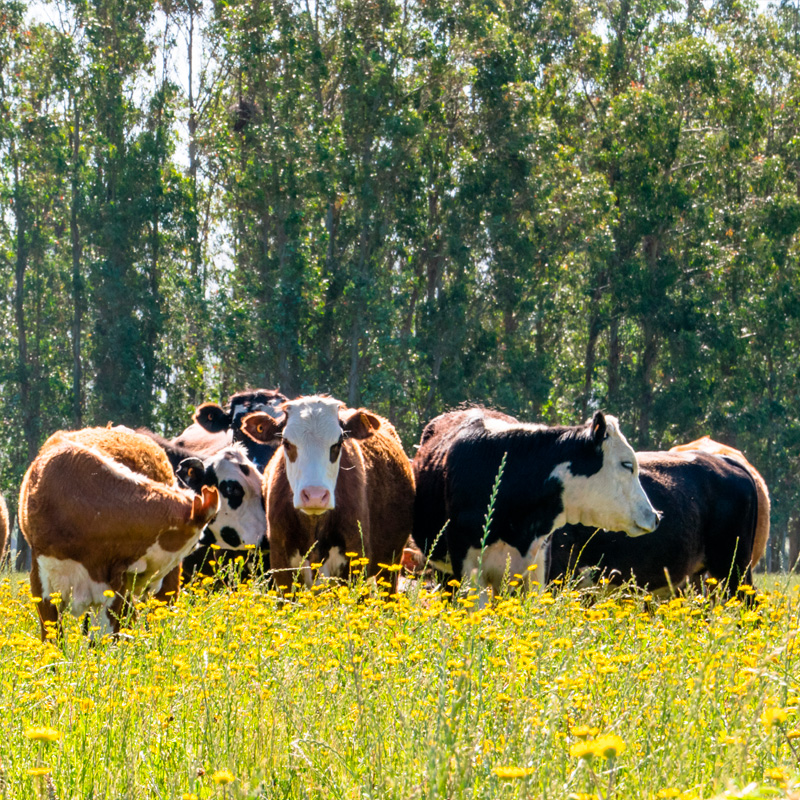
THE ORIGINS
Uruguay produces a meat that, among other South American countries, stands out for its quality. The main cattle breeds are Hereford and Aberdeen Angus, identified all over the world for their excellent quality. The excellence of the product is based on the type of farming. The animals, in fact, live in the open air, grazing in vast spaces.
The temperate climate and the rains favour the development of natural pastures, a perfect habitat that guarantees the livestock the possibility to live in total harmony with the environment. The result is a meat with a refined taste, high nutritional value, guarantee of origin and authenticity. Uruguayan meat is rich in Omega 3, Vitamin E (antioxidants) and has low fat levels. With its boundless spaces, colours and scents, Uruguay can inspire new, tasty and exotic recipes.
The temperate climate and the rains favour the development of natural pastures, a perfect habitat that guarantees the livestock the possibility to live in total harmony with the environment. The result is a meat with a refined taste, high nutritional value, guarantee of origin and authenticity. Uruguayan meat is rich in Omega 3, Vitamin E (antioxidants) and has low fat levels. With its boundless spaces, colours and scents, Uruguay can inspire new, tasty and exotic recipes.
|
|
|||||||||||||||
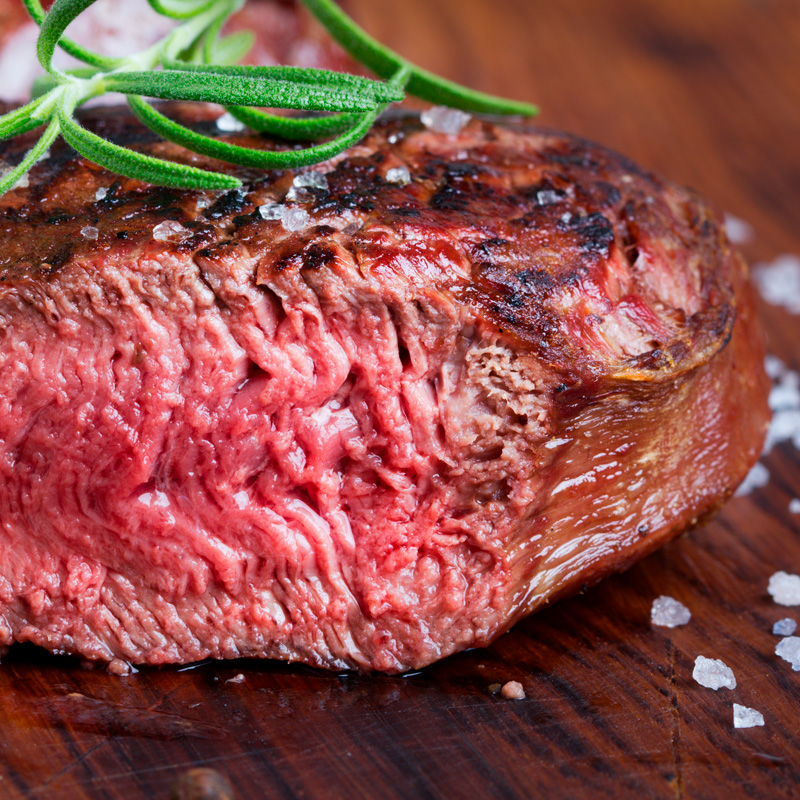
ENTRECÔTE
Very fine cut obtained from the sirloin of Uruguayan boneless beef. Thanks to the natural rearing in the open air and in total harmony with the environment, the meat is particularly tender, tasty and with very little fat, can be of varying thickness and lends itself to many different preparations: grilled, baked or in a pan. In France, the native land of this preparation, it is often accompanied by sauces of various kinds.
Preparation tips
Cooking mode Remove the packaging. Once the package is opened, it is recommended to oxygenate the product for at least 10 minutes so that it regains the typical colour of fresh meat.
Entrecote with orange-flavoured bacon
 Mix 6 chopped anchovy fillets, the peel of a blanched orange and some parsley leaves. Spread the mixture over 4 slices of meat and wrap each slice in bacon. Tie with kitchen string. Transfer the steaks to a baking tin, pour over the juice of a filtered orange, add rosemary, pepper and some orange zest. Bake in the oven at 180° for about 20 minutes. End the last 5 minutes with the grill function.
Mix 6 chopped anchovy fillets, the peel of a blanched orange and some parsley leaves. Spread the mixture over 4 slices of meat and wrap each slice in bacon. Tie with kitchen string. Transfer the steaks to a baking tin, pour over the juice of a filtered orange, add rosemary, pepper and some orange zest. Bake in the oven at 180° for about 20 minutes. End the last 5 minutes with the grill function.
FILLET STEAK
Absolutely softer and most valuable cut. From the lumbar area, the cut involves a muscle almost never trained by the beast, hence its unmistakable tenderness. Very small in size, it is a single piece that can be divided into three parts, each one perfect for different consumptions. It can be used for making steaks, tartare, carpaccio, chateaubriand, tournedos and filets mignon.
Preparation tips
Cooking mode Remove the packaging. Once the package is opened, it is recommended to oxygenate the product for at least 10 minutes so that it regains the typical colour of fresh meat.
Fillet with green pepper
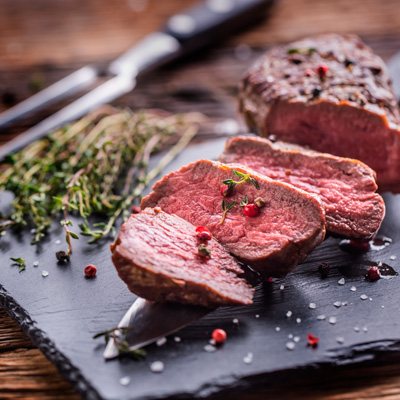 Wrap fillet medallions with kitchen string. In a mortar, crush a tablespoon of green pepper and stick it to the meat together with the salt.
Wrap fillet medallions with kitchen string. In a mortar, crush a tablespoon of green pepper and stick it to the meat together with the salt.Brown the fillets in a pan with butter, oil and a handful of peppercorns. Remove the meat from the pot, fade with brandy over high heat, lower the heat and add 150 ml of cream and a teaspoon of mustard. Put the fillet back in the pan and cook until the desired cooking level is reached. Remove the string and serve the fillet with hot green pepper.


ROAST-BEEF
Top quality cut, thin and wrapped in a thin strip of fat. It includes all - or almost all - the dorsal area of the animal. If with the bone, it is called rib eye, while without the bone, it provides sirloin steak.
Suitable for roasting and for the preparation of the typical English roast beef.
Preparation tips
Cooking mode Remove the packaging. Once the package is opened, it is recommended to oxygenate the product for at least 10 minutes so that it regains the typical colour of fresh meat.
Roast-beef in an aromatic herb crust
 Tie the roast-beef with kitchen string, rub it with salt and pepper and brown it in a well greased pan over high heat.
Tie the roast-beef with kitchen string, rub it with salt and pepper and brown it in a well greased pan over high heat.Transfer the meat to a baking pan with its cooking juices and place in a hot oven at 220°C for 15 minutes. Lower the temperature to 160°C and continue cooking for 45 minutes. Once cooked, roll the piece of meat into a chopped mixture of mint, sage, rosemary, bay leaf and garlic. Wrap the meat in aluminium foil and leave to rest for 15 minutes.
RUMP
A cut of rather fine beef that joins the thigh and sirloin. Low fat, tender and moderately digestible, the rump is extremely versatile in the kitchen: ideal for grilling, in the pan or in the oven, it can also be transformed into quality grinded meat. Less suitable for long cooking (boiled, braised and stewed).
Preparation tips
Cooking mode Remove the packaging. Once the package is opened, it is recommended to oxygenate the product for at least 10 minutes so that it regains the typical colour of fresh meat.
Slices of rump steak with pizzaiola sauce
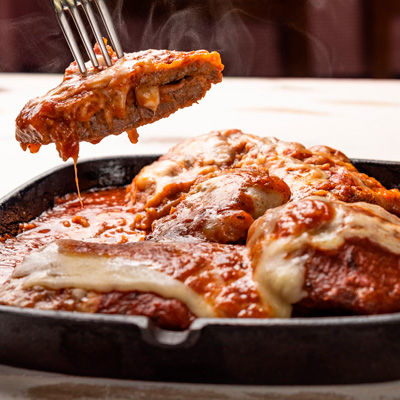 In a large pan make a sauce with 400 g of tomato pulp, oregano, capers, oil and salt. After a few minutes, add the slices of rump, cover with a lid and leave to cook for half an hour. When cooked, spread some mozzarella chunks over the meat.
In a large pan make a sauce with 400 g of tomato pulp, oregano, capers, oil and salt. After a few minutes, add the slices of rump, cover with a lid and leave to cook for half an hour. When cooked, spread some mozzarella chunks over the meat.Turn off the heat and let it rest until the cheese is completely melted.


HAMBURGER
Famous dish of minced and pressed meat. The different types of meat used must create a perfect mix between fat and firm meat in order to obtain the right balance between taste and juiciness.
It is mainly cooked in a frying pan or on the griddle and is eaten in a simple way or inside a sandwich with the addition of tomato, lettuce, cheese and sauces at will.
Preparation tips
Cooking mode Remove the packaging. Once the package is opened, it is recommended to oxygenate the product for at least 10 minutes so that it regains the typical colour of fresh meat.
Hamburger with caramelized onion and avocado cream
 Cook the burger on a hot plate. In a saucepan, soften the red Tropea onion with a tablespoon of sugar, salt, balsamic vinegar, a drizzle of oil, water and cook for 10/15 minutes over low heat to caramelize the onion.
Cook the burger on a hot plate. In a saucepan, soften the red Tropea onion with a tablespoon of sugar, salt, balsamic vinegar, a drizzle of oil, water and cook for 10/15 minutes over low heat to caramelize the onion.Toast the bread and make up the sandwich with spreadable cheese, salad, caramelized onions, meat, bacon and avocado cream (avocado, lime, oil and salt).
ANGUS
Toast the bread and make up the sandwich with spreadable cheese, salad, caramelized onions, meat, bacon and avocado cream (avocado, lime, oil and salt).
ANGUS
Very tender, juicy and savoury, Angus meat is smooth, compact and with thin filaments of fat which, once dissolved in the cooking process, release an intense aroma and enhance its softness. Rich in precious nutrients, 100 grams of Angus provide only 124 kcal (82% protein and 18% fat). A delicious and genuine dish.
Simple cooking methods (pan, plate, grill) are the best way to enhance and appreciate the noble qualities of the product.
Simple cooking methods (pan, plate, grill) are the best way to enhance and appreciate the noble qualities of the product.
Preparation tips
Cooking mode Remove the packaging. Once the package is opened, it is recommended to oxygenate the product for at least 10 minutes so that it regains the typical colour of fresh meat.
Sliced angus with rocket and cherry tomatoes
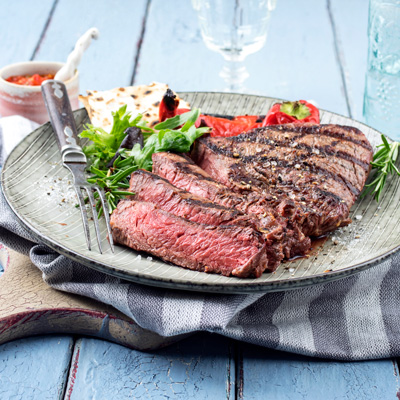 Heat a cast iron pot well and pour in a few grains of coarse salt. Place the meat on top and cook for 5 minutes on each side.
Turn it once, being careful not to sting it. Remove the meat from the heat and let it cool down; cut it obliquely into slices a couple of cm thick. Place the meat on a bed of rocket and cherry tomatoes. Add oil and salt.
Heat a cast iron pot well and pour in a few grains of coarse salt. Place the meat on top and cook for 5 minutes on each side.
Turn it once, being careful not to sting it. Remove the meat from the heat and let it cool down; cut it obliquely into slices a couple of cm thick. Place the meat on a bed of rocket and cherry tomatoes. Add oil and salt.

 ARGENTINA
ARGENTINAArgentina produces some of the best meats in the world for taste and tenderness. The goodness and peculiarities of Argentine meat can be traced back to the completely natural method with which the beef is reared. Left to live in the wild in the endless pampas, the animals feed exclusively on grass. This type of farming favours the production in the animal of substancesthat contribute to making the meat soft, tasty and healthy.
 BRAZIL
BRAZILBrazil, the world leading beef exporter, is increasingly highlighted by the quality of its meat. A
tender and tasty meat obtained through production systems in temperate, tropical pastures and intensive systems that
produce the most distinct quality specifications.
The healthy and natural diet of the animals guarantees the authenticity and safety of the meat and the preservation of the
environment.
 USA
USAAmerican meat is famous for its high level of marbling, i.e. the uniform spread of fat. This
particular characteristic makes the meat soft, juicy and with a strong and tasty taste.
Cattle are reared in a totally natural way and fed on a maize-based vegetarian diet without the use of supplementary hormones, growth promoters or additives.
Cattle are reared in a totally natural way and fed on a maize-based vegetarian diet without the use of supplementary hormones, growth promoters or additives.
 NEW
ZEALAND
NEW
ZEALANDNew Zealand meat is internationally recognized for its high quality, tenderness and delicious
taste.
The animals grow in an exceptional environment: in the open air, on rich and abundant pastures overlooking the Pacific
Ocean and with a mild and constant climate all year round. They are also subject to regular and very strict quality
controls. The result is a lean, nutritionally rich and high quality meat.
 AUSTRALIA
AUSTRALIAAustralia is known throughout the world to export high quality beef: very aromatic, tasty and with
a well-defined fat part. Tender and juicy thanks to the thin fibres and a high level of marbling. The cattle are reared
with a production system that is based on natural foods such as grass from pastures. The most prized and renowned
Australian meats are Black Angus and the highly prized Wagyu.
 PARAGUAY
PARAGUAYParaguay is one of the world leading beef exporters.
The excellence of Paraguayan meat is based on the type of farming. The animals, in fact, live in the open air in total harmony with the environment.
The meat is known for its marbled appearance, excellent tenderness and flavour characteristics, unbeatable taste and quality.
The excellence of Paraguayan meat is based on the type of farming. The animals, in fact, live in the open air in total harmony with the environment.
The meat is known for its marbled appearance, excellent tenderness and flavour characteristics, unbeatable taste and quality.
 CANADA
CANADACanada, one of the world's leading beef producers, selects the best breeds and raises them in a
pristine natural environment to provide the market with healthy, high-quality beef.
Canada's cool climate is an optimal habitat for animals. Canadian meat is known for its marbled appearance, excellent tenderness and flavour characteristics, unbeatable taste and quality.
Canada's cool climate is an optimal habitat for animals. Canadian meat is known for its marbled appearance, excellent tenderness and flavour characteristics, unbeatable taste and quality.
 JAPAN
JAPANKobe beef is a Japanese delicacy obtained from wagyu, a black mantle cattle of the Tajima breed.
Kobe meat is tender, very tasty and has an excellent taste. The merit lies in the marbling of the meat, which has a high
percentage of fat distributed evenly.
The registered trademark and the strict parameters imposed to define "Kobe's" meat, have made it a precious niche product,
renowned, expensive and sought after throughout the world.


